Costly Penny-Pinchers
They’re fervently collected by R.I. club,
the only one of its kind in the country
STORY BY ROBERT L. WHEELER — PICTURES BY JOHN P. CALLAHAN
PROVIDENCE SUNDAY JOURNAL . . . . . . JANUARY 3, 1954
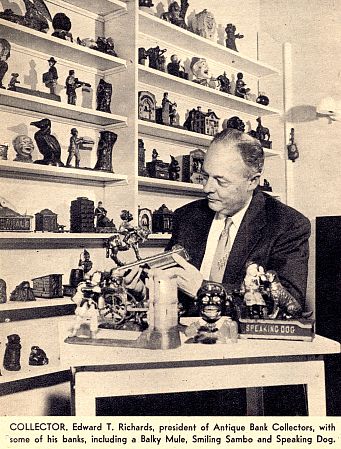 ONE MAN had a
Professor Pug Frog whose spring needed oiling. Use graphite, a fellow member advised.
Another said he knew where you could buy a Darktown Baseball Battery for $60, mint
condition. There was some discussion of an Uncle Sam that had just turned up and could be
had at a reasonable price. "Goatee work okay?" someone inquired.
ONE MAN had a
Professor Pug Frog whose spring needed oiling. Use graphite, a fellow member advised.
Another said he knew where you could buy a Darktown Baseball Battery for $60, mint
condition. There was some discussion of an Uncle Sam that had just turned up and could be
had at a reasonable price. "Goatee work okay?" someone inquired.
Still another man displayed a very good Shoot-the Chutes purchased at a country store auction in Massachusetts. Had to buy the entire contents of the store loft to get it but it was worth it, inasmuch as there are only a few Shoot-the Chutes in existence, fewer than a dozen, and this one was in the original box, the Stevens’ company’s No. 339, made in Cromwell, Conn., in 1909.
The club is the only one of its kind in the United States. It has nine regular members and they call themselves the Antique Bank Collectors of Rhode Island. To belong to it, you have to own a minimum of five listed toy banks, made in the days when the virtue of thrift was encouraged in children by presenting them with banks that did tricks for pennies. For the modest deposit of a cent in the proper place, Teddy Roosevelt would shoot a bear, a little girl would skip a skip-rope 53 times, the cow would kick over the milk pail, a dentist would pull a tooth. And so on. These banks were made of cast iron and were manufactured from around 1868 or 1869 to the nineteen-teens, when rising production costs killed the industry.
You can also belong to the Antique Bank Collectors of Rhode Island if you own a minimum of 25 "still" banks, which are less exciting. But whether you collect action banks or still banks, one thing’s for sure: In order to be a mechanical bank hobbyist you have to be fairly well supplied with what goes into banks. Collecting mechanical banks is now no sport for the financially crippled.
By way of illustration, the writer of this article once owned, some 55 years ago, a semi-mechanical bank. It was in the form of a lighthouse tower, with a dome at the top and a spring in the bottom, and the tower held exactly 100 pennies; you could look through little windows and see your wealth increasing, day by day. When the tower was full of pennies, you pressed the dome at the top down on them and that released the spring at the base of the tower and out tumbled a dollar’s worth of coppers. I suppose my parents must have paid all of a dollar and a half to get this bank for me.
The other night I visited the home of a member of the Antique Bank Collectors club and he showed me his banks. The ones he thought the most of were in two panels in the dining room. There on the top shelf was my lighthouse bank! I asked my host what it was worth and when he answered me in three figures my face assumed a wistful expression and kept it all the evening.
 Any collector of mechanical banks will warn you against allowing yourself to be bitten
by this particular hobby bug. The game is definitely getting rough and you need money to
sit in.
Any collector of mechanical banks will warn you against allowing yourself to be bitten
by this particular hobby bug. The game is definitely getting rough and you need money to
sit in.
The club holds four regular meetings a year and this was one of them. It was held at the home of DeForest W. Abel, 83 Loring Ave., and there were present, besides the host, who is president of the Automobile Mutual Company of Providence, two other company presidents, Edwin M. Caldwell Jr. (Caldwell Motor Company, West Warwick) and W. W. Yando (Braided Rug and Specialties Company, Pawtucket); a man in the building materials business, Oliver I. Clark; an attorney, Edward T. Richards (Edwards & Angell); and a stock clerk at Central High School, Rudolf A. Salvatore.
Also a banker, Frederick L. Macalister, assistant manager of the Slater branch of the Industrial Trust. Another banker, Rupert C. Thompson, president of the Union National Bank of Providence, couldn’t make it. Neither could Donald B. Derby, president of the U.S. Finishing Company, Norwich, Conn., and the Collectors’ only out-of-state member. There are two honorary members, F. L. Ball of Cambridge, Mass., dean of dealers in mechanical banks, and Andrew Emerine, Fostoria, an internationally known collector.
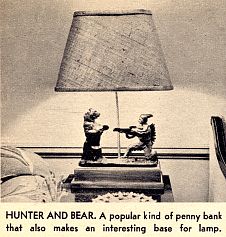 Lawyer Richards is president of the Antique Bank Collectors of Rhode Island and Stock
Clerk Salvatore is secretary-treasurer. After talking mechanical banks for about so long
the Collectors lunched on chicken sandwiches and pumpkin pie and then went back and talked
mechanical banks some more.
Lawyer Richards is president of the Antique Bank Collectors of Rhode Island and Stock
Clerk Salvatore is secretary-treasurer. After talking mechanical banks for about so long
the Collectors lunched on chicken sandwiches and pumpkin pie and then went back and talked
mechanical banks some more.
This reporter mentioned the lighthouse bank he owned when he was a boy to one of the Collectors and the latter said yes, he had a chance to acquire one once, a lady who was using it for a table decoration offered it to him for free if he would rent her apartment. They couldn’t come to terms.
The history of mechanical toys goes back a long way. When you come right down to it, what was Friar Roger Bacon’s talking skull but one? And of course there were the cathedral clock jacks of medieval times, the little figures that came out when the hours struck, and jerkily gestured. The Robot was with us long before the play R.U.R. gave him a name. But it remained for the New England Yankee to originate a type of toy that performed for a penny, presumably to inculcate habits of saving and giving you action for your money.
"Still" penny banks made their appearance fairly early in the history of the Republic. The first large penny pieces were issued by the U.S. Treasury in 1793, and before long there were penny banks of wood and clay for the youngsters to stash the occasional copper. Some of them were made of glass. And sometimes the penny bank was just a gourd with a slit in it.
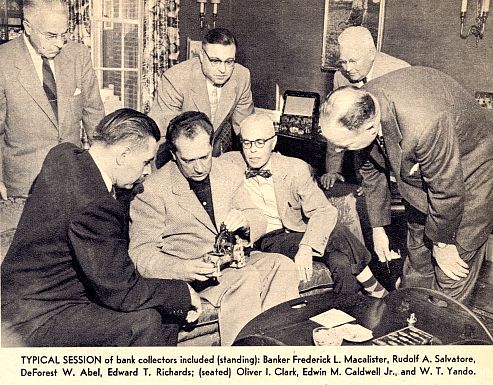
THESE banks, however, were mere receptacles for money. You deposited your penny and that was that; the only reward you received for being saving was the knowledge that you had money you couldn’t get at except by using force and violence. The only fun you got out of one of these box-like affairs was prying it open to get your money back.
In 1869, however, a certain John Hall, a citizen of Watertown, Mass., devised a penny bank that made saving fun. He invented the patented "Hall’s Excelsior Bank," a rather simple affair, just a little cast-iron house with a bell and cupola. But when you pulled the bell, something interesting happened. Up flipped the roof of the cupola and up popped a monkey who accepted your penny — and down-popped. He would do this as many times as you could wring pennies from papa.
Mr. Hall’s ingenious incitement to thrift was an instant success and he promptly put it into production. Hundreds were manufactured and a new industry was born.
Within a few years, other craftsmen of inventive bent were following Hall’s example and designing figures that did astonishing things for a penny. They continued to do them for upward of half a century, building up a repertoire of 240 to 245 different acts which ransacked the broadening field of American life for humorous, satirical and sporting motifs.
They were men of powerful imagination, these craftsmen. Their names, except in a few instances, have not come down to us. It is likely, however, that they were mostly Connecticut Yankees (who rate as the most mechanically ingenious of God’s created beings), for the center of the industry was the town of Cromwell, Conn., where J. E. Stevens and Company became the classic manufacturers of penny banks. There were others, of course, notably the Shepard Hardware Company of Buffalo, N.Y., and the Kenton Hardware Company of Kenton, Ohio. But today Cromwell, Conn., is practically the Holy City to collectors of old mechanical banks.
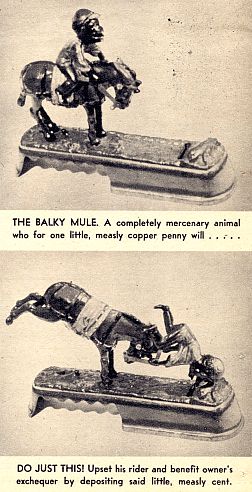 SOME of the mechanical bank themes were political. There was one, the prized
"Secore’s Freedman’s Bank," (now worth more than $2,000) which
couldn’t have been too popular in the post-bellum South. The figure, a Negro seated
at a counter, thumbs his nose as he deposits your penny — presumably cocking a snoot
at Old Massa!
SOME of the mechanical bank themes were political. There was one, the prized
"Secore’s Freedman’s Bank," (now worth more than $2,000) which
couldn’t have been too popular in the post-bellum South. The figure, a Negro seated
at a counter, thumbs his nose as he deposits your penny — presumably cocking a snoot
at Old Massa!
The so-called "Tammany Bank," patented in 1871, features a suave, plump gent who has been erroneously identified as Boss Tweed of unholy memory. He resembles Tweed in no particular, but the fact that the design was taken as symbolic of political corruption is significant of the way American mechanical banks reflected American thinking.
The varied, colorful life of the circus inspired many designs — tumbling clowns, trapeze performers, circus animals from the elephant to the wild kangaroo. The Irishman and the Negro, stock comic figures in those days, figure prominently. It isn’t so many years since a "Paddy and the Pig" bank, displayed in a bank window in New York, caused sensitive Irish-Americans to bound with indignation. And in these days of touchy race consciousness, it isn’t difficult to imagine the Jolly Dinahs and pickanninies and darky jockeys of early mechanical banks raising quite a ruckus. We still had a frontier then, so there were Indians and buckskinned marksmen. "T.R." fired a penny into a hollow tree and a wounded bear stuck out his tongue for it. And William Tell shot the apple off his son’s head and saved himself and Junior a penny.
Baseball and football both figured in mechanical bank acts. Darktown Batteries hung up strike-out records, and tacklers closed in on ball carriers. Just why the classic football bank was named "Calamity" nobody knows. The only war the mechanical banks made use of was our romantic war with Spain, with Dewey’s fleet figuring prominently.
Whatever the motif of a mechanical bank, its basic mechanical principle was the same — a spring so adjusted that the added weight of a penny put the moving parts in motion by releasing it.
World War I might have supplied the industry with a lot of new action themes but by 1915 or thereabouts, the business was on its last legs, hence there are no Submarine, Airplane or Kaiser Bill banks. Labor costs were rising and it was no longer possible to paint mechanical banks at a penny a bank.
In the late 1920’s, a few people began collecting mechanical banks.
It became a small, inexpensive hobby. Then it became a big, expensive one. And today, the Antique Collectors of Rhode Island tell you with a sigh, Things Are Really Tough.
The best hunting grounds are still New England, Pennsylvania and upper New York State. But the old country stores and their dim, dusty attics have been combed over pretty well. And prices have gone up. A Circus Ticket Collector once purchased for $9.50 may be worth $300 now. And the little girl skipping rope, 53 skips for a penny, might today be considered a good buy at $675 and would certainly represent a nice profit to the collector who picked her up for $4.25.
The financial aspects of mechanical bank collecting are important, but equally important is the fact that the banks themselves are fun, both to look at and operate. This is particularly the case when the collector has children or grandchildren.
THE collection pictured by The Rhode Islander today is owned by Edward T. Richards, the Antique Bank Collectors’ president, who lives at "Hedgerow," near Kingston. Mr. Richards has 120 of the 240 to 245 types of mechanical action banks in existence besides a large collection of stills. His collection fills two large panels in the dining room and one entire room of the house. And there is even an immense frog bank greenly staring up at you from the dining table, to say nothing of a crossbowman-and-bear bank which has been made into a lamp base.
Mr. Richards’ collection has not increased greatly in the last few years and one can see why. While he was showing it to us, the phone rang and Richards was out of the room quite a while.
When he came back he said to Mrs. Richards, "Dear, I know of a very good mechanical bank I can have for $1,500." Mrs. Richards did not reply. Things are indeed tough, very tough.
Web Note: Many thanks to MBCA member Ted
Richards for providing an original copy of this article at our 2002 convention
in Providence, Rhode Island. He was MBCA President from 1970 through 1972 and
editor in 1971 and 1972. His father, Mr. E. T. Richards, was founder of the
MBCA and its President from 1958 through 1964.
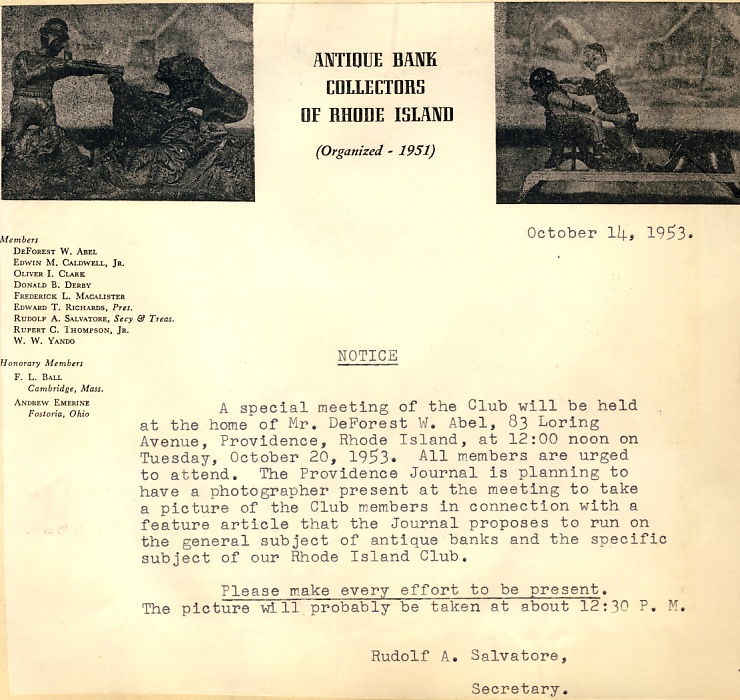
Also see: Rhode Island
Collector Club - Correspondence
ANTIQUES - September 1955, page 268.
Old banks for young museum visitors
The Connecticut Historical Society, 1 Elizabeth
Street, Hartford, is presenting a loan exhibition of old mechanical banks
especially arranged for children. When we questioned the director of the
society, Mr. Thompson R. Harlow, about the genesis of this idea he replied that
the subject of mechanical banks had been settled on in the first place because
of its interet for a Connecticut audience—so many of these toys having been
made in the state in the 1800's. In the course of arranging with several private
collectors to exhibit their material, he wrote, it was realized that old banks
represented a field of collecting "in which entire families
participated." Accordingly, the whole emphasis was put on showing how the
banks work (there is even one on display, "a Security Safe Deposit"
belonging to the society, that children are allowed to drop pennies in). For the
historically-minded, old catalogs, labels, and patents of early Connecticut
manufacturers of mechanical banks are also on view. An exhibition of cap and
animated pistols is already being planned along the same lines for next year.
